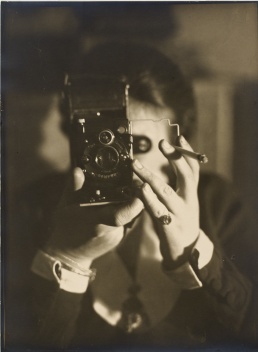Difference between revisions of "Germaine Krull"
(Created page with "'''Germaine Krull''' (1897-1985) was a pioneer in the fields of avant-garde photomontage, the photographic book, and photojournalism, and she embraced both commercial and arti...") |
|||
| Line 1: | Line 1: | ||
| + | [[Image:Krull Germaine 1925 Self-Portrait with Cigarette.jpg|thumb|258px|Germaine Krull, ''Self-Portrait with Cigarette'', 1925.]] | ||
'''Germaine Krull''' (1897-1985) was a pioneer in the fields of avant-garde photomontage, the photographic book, and photojournalism, and she embraced both commercial and artistic loyalties. | '''Germaine Krull''' (1897-1985) was a pioneer in the fields of avant-garde photomontage, the photographic book, and photojournalism, and she embraced both commercial and artistic loyalties. | ||
Revision as of 10:34, 10 October 2017
Germaine Krull (1897-1985) was a pioneer in the fields of avant-garde photomontage, the photographic book, and photojournalism, and she embraced both commercial and artistic loyalties.
Born in Wilda-Poznań, East Prussia, in 1897, Krull lived an extraordinary life lasting nine decades on four continents—she was the prototype of the edgy, sexually liberated Neue Frau [New Woman], considered an icon of modernity and a close cousin of the French garçonne and the American flapper. She had a peripatetic childhood before her family settled in Munich in 1912. She studied photography from 1916 to 1918 at Bayerische Staatslehranstalt für Lichtbildwesen [Instructional and Research Institute for Photography], and in 1919 opened her own portrait studio. Her early engagement with left-wing political activism led to her expulsion from Munich. Then, on a visit to Russia in 1921, she was incarcerated for her counterrevolutionary support of the Free French cause against Hitler. In 1926, she settled in Paris, where she became friends with artists Sonia and Robert Delaunay and intellectuals André Malraux, Jean Cocteau, Colette, and André Gide, who were also subjects of her photographic portraits.
Krull’s artistic breakthrough began in 1928, when she was hired by the nascent VU magazine,the first major French illustrated weekly. Along with photographers André Kertész and Éli Lotar, she developed a new form of reportage rooted in a freedom of expression and closeness to her subjects that resulted in intimate close-ups, all facilitated by her small-format Icarette, a portable, folding bed camera. During this period, she published the portfolio, Metal (Métal) (1928), a collection of 64 pictures of modernist iron giants, including cranes, railways, power generators, the Rotterdam transporter bridge, and the Eiffel Tower, shot in muscular close-ups and from vertiginous angles. Krull participated in the influential Film und Foto, or Fifo, exhibition (1929–30), which was accompanied by two books, Franz Roh’s and Jan Tschichold’s Foto-Auge and Werner Gräff’s Es kommt der neue Fotograf!. Fifo marked the emergence of a new critical theory of photography that placed Krull at the forefront of Neues Sehen or Neue Optik [New Vision] photography, a new direction rooted in exploring fully the technical possibilities of the photographic medium through a profusion of unconventional lens-based and darkroom techniques. After the end of World War II, she traveled to Southeast Asia, and then moved to India, where, after a lifetime dedicated to recording some of the major upheavals of the twentieth century, she decided to live as a recluse among Tibetan monks. (Source)
